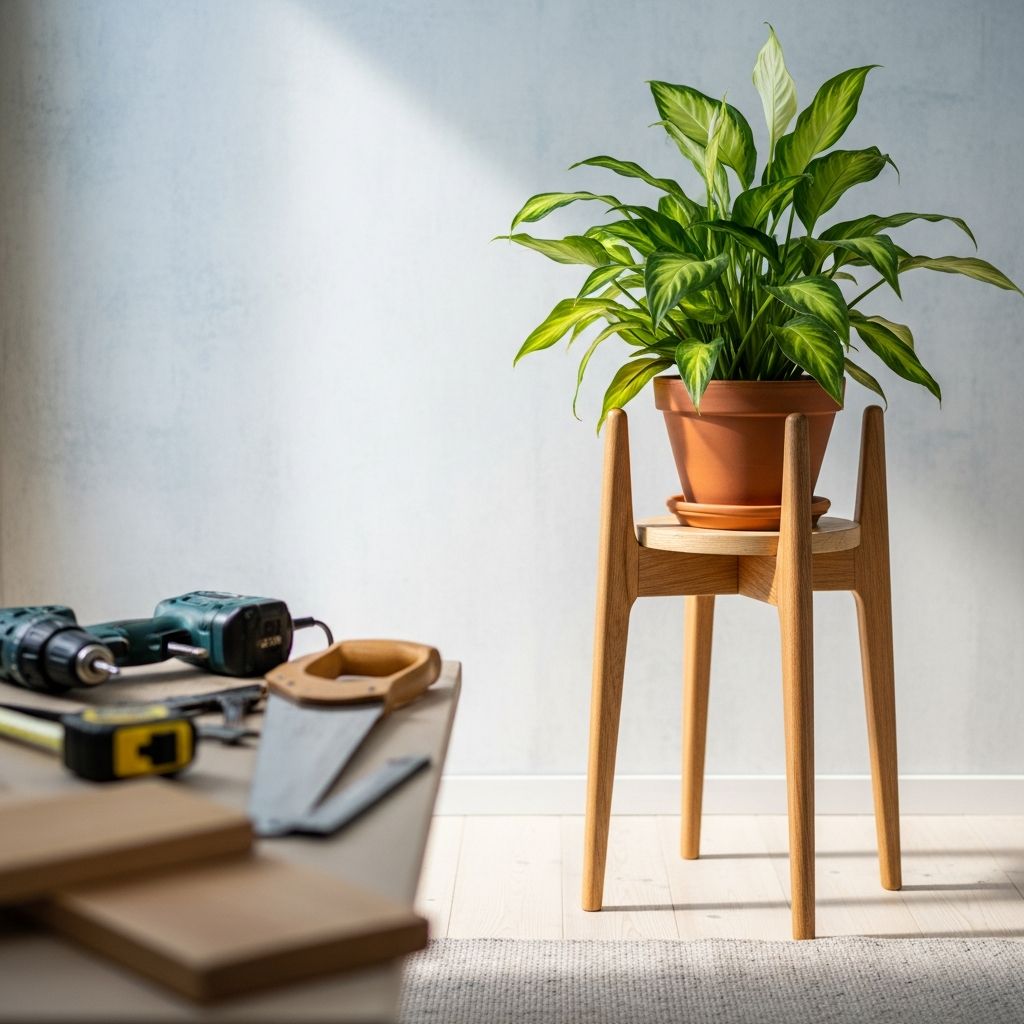Wooden Mid-Century Plant Stand DIY: Step-by-Step Guide
Craft a stylish mid-century wooden plant stand with this complete DIY guide – from choosing materials to troubleshooting your build.

Wooden Mid-Century Plant Stand DIY: A Complete Home Decor Project
Adding a mid-century wooden plant stand to your home not only elevates your greenery but also introduces an iconic element of design that bridges modern minimalism with retro charm. Building one yourself offers flexibility in size, color, and finish, ensuring a custom fit that matches your personal style and room decor. This guide breaks down each step in the process, providing detailed instructions, expert tips, and troubleshooting advice to help both beginners and DIY veterans successfully complete the project.
Why Build a Mid-Century Plant Stand?
- Versatility: Complements various interior styles from retro to contemporary.
- Space Efficiency: Elevates plant pots, using vertical space without crowding surfaces.
- Customization: Tailor dimensions, wood stain, and finishes to your specific needs.
- Durability: High-quality wood stands last longer than many store-bought alternatives.
- Satisfying Project: Accessible to beginners and fulfilling for seasoned makers.
Materials and Tools: What You’ll Need
Before starting, gather all necessary materials and safety equipment. The following list reflects standard supplies used in classic mid-century stands, but you can adjust based on pot size or available wood.
- Wood: 1.5-inch wide boards for the base X and side legs (around 4 to 8 feet, depending on stand size).
- Saw: Jigsaw recommended; hand saw or circular saw as alternatives.
- Drill: For making holes in the boards.
- Wood Glue: Ensures stronger joints and a seamless finish.
- Screws: For extra reinforcement (preferably flat-head screws).
- Ruler & Measuring Tape: For precise measurements.
- Pencil or Marking Pen: For marking where to cut.
- Sandpaper: For smoothing sharp edges and achieving a clean surface.
- Paint or Stain: To match your decor or desired look.
- Safety Gear: Protective eyewear and a dust mask.
Optional additions include wood plugs for hiding screws, pocket hole jig for clean drilling, clamps for glue-up, and wood filler if you want to conceal any imperfections.
Step One: Measuring and Planning
Carefully planning your measurements ensures the stand fits your plant pot perfectly and stands securely. Here’s how to get it right:
- Measure the diameter of your plant pot and add about half to one inch for clearance.
- Decide on stand height: Combine the height you want your pot to sit off the ground with the length you want the legs to extend up the sides of the pot.
- Determine board length: X-base boards usually match the pot’s diameter plus clearance; legs often range from 12 to 18 inches for most medium pots.
Tip: Draw a quick sketch or write down your measurements before you begin cutting. Consider making stands at different heights for a layered plant display.
Step Two: Cutting the Boards
Cutting accurately is critical for stability and a polished look. You’ll need the following cuts:
- Base X Pieces: Cut two identical lengths as measured for the base (e.g., 12.5 inches for a 10–12″ pot).
- Leg Pieces: Cut four identical pieces for the legs (e.g., 13-inch long boards for a medium-height stand).
Mark each cut clearly with a pencil and double-check with your ruler to ensure symmetry and structural balance.
Step Three: Creating the X-Base Notches
The iconic X at the base is not only decorative—it’s what holds the pot securely. Here’s how to create the notches for a perfect joint:
- Use a ruler to find and mark the center of both base boards.
- Trace a notch on each board at the center, as wide as the thickness of your board and as deep as half its height (e.g., for a 1.5-inch wide board, mark a 0.75-inch deep, 1.5-inch wide notch on both boards).
- With a jigsaw, cut along the marked lines down the sides.
- Since jigsaws can’t make right-angle turns, drill a hole at the end of the center cut to create a starting point for your blade to cut across the bottom.
- Work carefully across the bottom of the notch, then repeat from the other side if necessary.
- Test-fit the boards by sliding them together; they should orient flush in a cross shape.
Tip: Sand the notched edges for a snug and splinter-free fit.
Step Four: Assembling the X-Base
With your notches cut, assemble them to form the stand’s base. This part determines how steady your plant stand will be.
- Apply wood glue to the contact points within each notch.
- Press the pieces together firmly to form a flush X shape.
- Optionally, reinforce with a flat-head screw through the center where the pieces join for extra stability.
- Wipe away any excess glue before it dries for a clean finish.
Set the base aside and let the glue cure per manufacturer instructions (typically 30-60 minutes under light pressure).
Step Five: Preparing and Attaching the Legs
Leg attachment is where your stand gains its height and classic silhouette. Proceed methodically for even and lasting support:
- Measure and mark the base for four equidistant attachment points.
- Hold each leg upright at a right angle to the base’s end (legs may align vertically or flare slightly outward—this is a stylistic choice).
- Use wood glue at each joint, then secure with a screw driven through the base into the leg (predrilling pilot holes prevents splitting).
- Repeat for all four legs, checking frequently with a level for consistent height and stability.
- If desired, attach legs halfway up the sides of the pot for a mid-century “hugging” effect, or flush with the top for a lower profile.
Allow at least one hour for the glue to fully set before proceeding.
Step Six: Sanding and Finishing the Stand
Refining the wood and adding a protective finish gives your stand a professional appearance and greater longevity.
- Use medium-grit sandpaper to smooth cut edges, surfaces, and any glue residue.
- Follow with a finer grit for an ultra-smooth feel, paying extra attention to corners and notched joints.
- Remove dust with a tack cloth or slightly damp rag.
- Apply your chosen paint or stain with a brush or cloth, following the wood grain.
- Allow stain or paint to fully dry before applying additional coats or a sealer.
- If using wood plugs to conceal screws, install them now and stain to match.
Popular stains for a mid-century look include warm walnut, medium oak, or rich cherry. Painted finishes in black or white also provide a modern-retro vibe.
Step Seven: Final Assembly and Placement
- Once completely dry, check all joints for stability; tighten screws or add glue as needed.
- Test-assemble with your intended plant pot and adjust for comfort and security.
- Place felt furniture pads under each leg to protect floors, especially if used indoors.
- Set the finished stand in your preferred location and add your favorite plant for an instant design upgrade.
Design Variations and Advanced Tips
Once you’ve mastered the basic build, try these creative adaptations:
- Different Heights: Make sets of stands at staggered heights for a dynamic grouping.
- Double-Layer Stands: Add a secondary shelf to hold a second, smaller pot.
- Alternate Finishes: Try two-tone paint or dip-dye techniques for a fresh twist.
- Material Swap: Replace wood with bamboo or painted dowels for distinct effects.
- Outdoor Use: Apply a waterproof clear coat to make your stand weather-resistant.
Troubleshooting Common Issues
| Problem | Solution |
|---|---|
| Notches don’t fit tightly | Sand edges or add a dab of wood glue and clamp for a snug joint. |
| Stand wobbles on flat surfaces | Double-check leg lengths, sand ends to correct, or add felt pads. |
| Wood splits when screwing | Predrill with a smaller drill bit before inserting screws. |
| Visible screw heads | Use wood plugs, countersink screws, or fill with colored wood filler before sanding and staining. |
| Finish looks uneven | Ensure all dust is removed before staining and apply evenly in the wood grain direction. |
Maintenance and Care Tips
- Wipe with a dry or slightly damp cloth to clean; avoid harsh chemicals or soaking.
- Refresh the finish annually by sanding lightly and re-staining if needed.
- Protect against heavy water spills by using a planter with an integrated saucer or tray.
- Inspect screws and joints every few months for tightening or repairs.
- For outdoor stands, bring indoors during extreme weather to prolong lifespan.
Frequently Asked Questions (FAQs)
Q: Can I make this stand if I have limited experience with woodworking?
A: Absolutely! This project is beginner-friendly, requiring only basic cutting and assembly skills. Just ensure proper measurements and cautious tool use for best results.
Q: What is the best wood for a durable plant stand?
A: Hardwood species such as oak, maple, or walnut offer durability and classic appearance but are costlier. Pine or poplar provide a budget-friendly alternative, ideal for indoor use.
Q: Should I glue, screw, or both when assembling my stand?
A: For maximum strength, use both wood glue and screws. Glue provides solid adhesion while screws ensure the joints withstand regular use and weight.
Q: My boards don’t fit together perfectly. How can I fix this?
A: Sand down the edges carefully and add small amounts of wood filler if any gaps remain. Precision in marking and cutting also helps prevent fit issues.
Q: Can I disassemble the stand for storage?
A: If the X-base is not glued, it can be taken apart easily for compact storage. For permanent stability, glue all joints and avoid disassembly.
Q: How do I keep my floor safe from scratches?
A: Attach felt pads or rubber bumpers under each leg, especially on hardwood or tile floors.
Conclusion
Building your own wooden mid-century plant stand is an accessible and rewarding DIY project that enhances your living space while giving your plants a stylish home. Whether you follow the classic steps or put your own twist on the design, you’ll end up with a functional and beautiful stand that’s sure to draw compliments. Gather your materials, take your time with each step, and enjoy both the process and the results of your handiwork.
References
- https://www.neverskipbrunch.com/midcentury-modern-plant-stand-diy/
- https://www.houseofhawthornes.com/mid-century-plant-stand-diy/
- https://www.instructables.com/Mid-Century-Modern-Plant-Stand/
- https://retrorenovation.com/2012/08/02/how-to-build-a-mid-century-inspired-planter-stand-in-8-easy-steps/
- https://abeautifulmess.com/wooden-mid-century-plant-stand-diy/
- https://www.youtube.com/watch?v=ITDz-Zzod1Q
- https://www.youtube.com/watch?v=V7QZK4wfyuw












